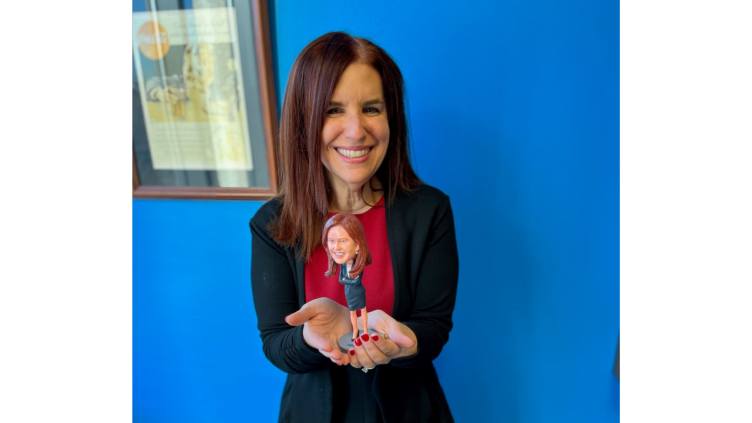3 Ways to Have More Fun at Work – and One Thing You Should Never Do

Are you are used to keeping certain items separate? You know, things like church and state, ensuring the peas on your plate go nowhere near the mashed potatoes and always sitting your mom and Aunt Edna at opposite sides of the room to avoid World War III.
Apply that to the workplace, and you might have cranked your way through years or even decades determined that fun and work should never be intermingled. (And in that case, we are not going to be having lunch together anytime soon – hey, I’m just saying.)
However, research has shown that integrating fun into the workplace has numerous benefits.
In this Harvard Business Review article called Why Work Should Be Fun, employee recognition expert Bob Nelson, PhD, said “Though fun at work is sometimes thought to be a distraction, research suggests that it has a positive impact on engagement, creativity, and purpose — increasing employee retention and reducing turnover. When we find tasks enjoyable, we’re more eager to dig in and complete them. When we make time for joy and laughter, we become resilient.”
He recounts the process of researching what makes a job fun by analyzing the publicly available variables used by Great Places to Work to rank their annual 100 Best Places to Work For list. They found that 81% of companies ranked as great described office environments as fun while at companies that applied for and didn’t make the list, only 62% of employees did the same. “This 19-point gap was one of the largest distinctions we found, reiterating previous research that suggests ‘fun’ is essential to a great work culture,” Nelson explained.
Lorraine Margherita, an international collaborative consultant, says that humans can’t survive without fun. That is especially true in the workplace, where so many of us spend a huge chunk of time.
“We are social animals and having fun is one of the ways we interact. Work is a place where we need the interaction and the innovation fun can bring,” Margherita told me. “When we talk about fun and play, it doesn’t require the entire office to become a giant playground! In 2023 we know that fun and serious combine very well at work; work doesn’t have to be boring or sad. Customers will promote brands with a sense of fun, and it can be a great asset with employees.”
Better Relationships
Having fun at work can help you create stronger relationships with others. Think about it. Once you’ve gotten to know individuals in a more positive light, even building friendships, it increases your personal investment in supporting each other to deliver results.
Harsha Boralessa, host of the popular “Reframe & Reset Your Career” Podcast, agrees. “I’ve found that the working environments which have been fun have led to stronger relationships between team members and you’re willing to go the extra distance to get the job done,” he said. “This is especially important if there are things that are not that interesting but just need to get done.”
Margherita has observed that fun and emotions are related to having a sense of purpose in life. “We all need meaning in what we do, in our personal and professional endeavors. The ability to have fun means that employees can acknowledge and express their emotions and desire, which has a huge impact on loyalty and performance.”
Want to add more fun to your culture? Here are three ways to get started:
1. Make Fun a Corporate Value.
Some companies are known for having a fun culture. Zappo’s, Google, and Southwest Airlines come to mind, though each has faced a recent surge of challenges. However, you don’t have to be a large corporation to embrace elements of fun. Organizations of any size can make fun a corporate value.
In fact, that’s what attracted Juliana Vida to her current role. The technology thought leader and aviation expert is a proud, retired military officer.
“Having come from a full military career and eight consecutive years in the Pentagon, I had never considered fun as an element of work, and certainly not endorsed by a company’s leadership as being valuable,” she explained. When Vida learned from the hiring manager that fun was one of the organization’s five corporate values, it prompted her to take the job. She has since seen fun incorporated at all levels and job functions across the company.
“Now, I work in a publicly traded software company that’s serious business. It’s not all jokes and sunshine every day,” continued Vida. “But holding fun as a corporate value is a permission slip for people to bring their best to work, and not worry what they consider fun that others might find kooky or strange.”
“When people feel they’re having fun, they engage so much more deeply,” she added. “Though we worked hard/played hard in the military and certainly had our share of fun on and off duty, it certainly wasn’t our focus or that of our leadership. I cringe to think of how much less stress, PTSD, and serious mental health issues could have been avoided if it were more accepted and even encouraged to incorporate fun into everyday work, where it didn’t affect normal operations.”
Making fun a corporate value involves naming it within the desired traits of your culture. You see it in the employee manual, on banners and embossed on company swag. Then it is important to reinforce fun by rewarding and recognizing the successful applications of that behavior within company communications, employee events, internal awards and more.
2. Serve as a Fun Role Model.
Embracing fun, as with so many factors, starts with company leadership. When you have fun and recognize it as a positive trait, it reinforces the desirability of that behavior. You don’t have to be in the C-Suite or wait for others to initiate though. It can all start with a smile, according to Executive & Leadership Career Coach Darcy Eikenberg, PCC.
“I think the easiest way to have fun is to be fun, which can be as simple as just smiling more,” said Eikenberg. “The truth is a genuine smile can make us more accessible and convey that things are going well. A core way leaders can create psychological safety is to signal that it’s okay for us to smile and laugh and have fun here no matter what’s going on, no matter how hard the work is.”
“Leaders showing they have fun and encouraging it in others makes us more human, relatable, accessible to people,” noted Vida. “Everyone feels like there’s a level playing field, that the fun times aren’t just for the younger folks. It can break down the barriers of hierarchy and power, which are so important in cultures that encourage true servant leadership.”
Sounds simple, doesn’t it? Smile more during in-person and virtual meetings when you are feeling it, and feel free to display your sense of humor. After a few weeks I bet you’ll notice more people having fun and being their authentic selves at work.
3. Be Appropriate.
Fun, like beauty, really is in the eye of the beholder. For some, it could be having an impromptu laugh with co-workers or sharing humorous memes, while for others, fun entails regular karaoke nights or major team building events.
Understand what works best for your culture, teams, and specific individuals. Even within your overall company, different departments can have their own personality. One size of fun doesn’t fit all.
“For culture in general and fun in particular, there is no such thing as a single rule for everyone,” said Margherita. “I believe that the key for teams to enjoy fun in the workplace is to let them have their word in suggesting and choosing options. It is counterintuitive to force people to come and have fun but if the fun activities match the organization’s culture, it shouldn’t be a problem.”
Personally, I try to have a fun lunch with other members of our executive team at least once a week. During my communications team’s weekly virtual staff meeting, we share whatever is on our mind and have a safe space to laugh at whatever is stressing us out. In Vida’s organization, she notes that incorporating fun is as simple as adding a cute emoji or .gif in an internal slack or other channel, or wearing kooky, irreverent but inoffensive t-shirts with clever slogans.
Now, let’s talk about the one thing you should NEVER do. DO NOT legislate fun.
Making fun mandatory is the quickest way to suck the joy out of a room.
Eikenberg has witnessed too many leaders trying to legislate fun with games or random outings instead of considering how they can make the work they are doing in the moment lighter and more enjoyable with moments of real human connection.
The biggest challenge is that everyone has different definitions of what is enjoyable. Team members with young kids may feel pressured to go out to company sponsored happy hours while not everyone (myself included) likes the idea of showing up in a bathing suit during a family day at the local water park. As noted in this Wall Street Journal article “For some, there’s nothing less fun than company-sponsored ‘fun’ with co-workers.”
“The danger of legislating fun at work is that very often it can flop and even worse, you may never get that feedback,” noted Eikenberg. “You may have had fun at the gaming place, at the breakout room, at the pizza party. But your staffer with the gluten intolerance, who had a stomachache all the next day because she didn’t think she could say no — that wouldn’t be fun at all.”
How does fun manifest in your culture? What tips can you share to encourage more fun in the workplace?
